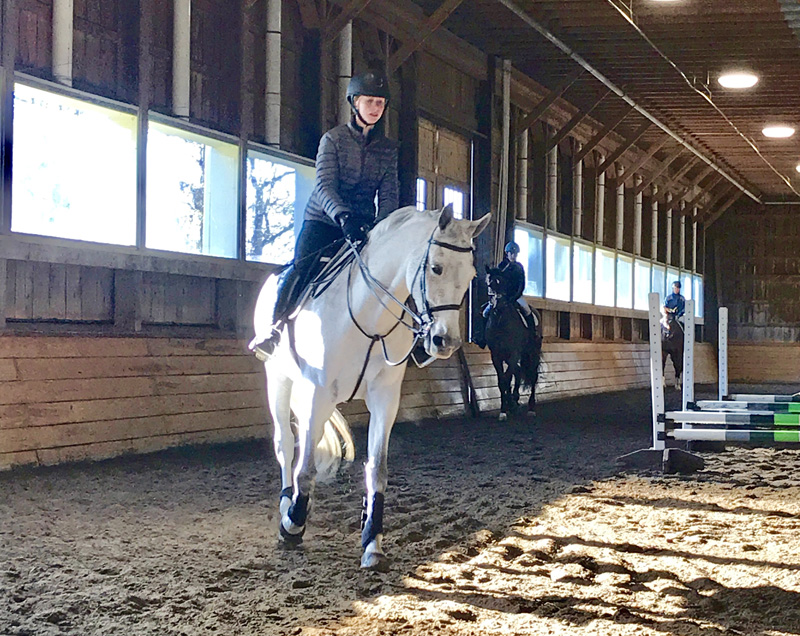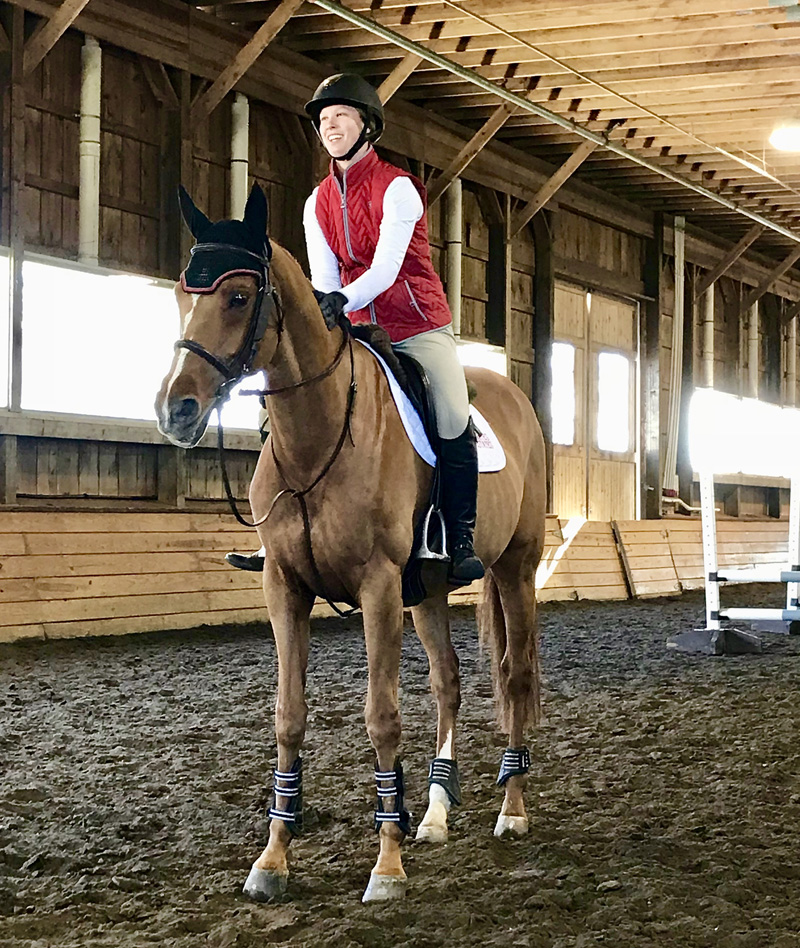The first day of Anne Kursinski’s clinic held at her farm, Market Street Inc., in Frenchtown, N.J., focused on the basics. She emphasized, “Position, position, position. If you can’t control your position, good luck controlling your horse.”
She had the riders warm up at the posting and sitting trot and focus on being aware of their spacing. When the spacing between horses got too close, instead of circling, she emphasized being able to control the gaits and to speed up or slow down to keep the distance between horses the same. She said, “You’re aware of the space, that’s what jumping is about.”

Anne Kursinski cautioned riders to be aware of the spacing between their horses and wanted them to control it with their pace. Photo by Kiira Lizza
Anne had all the riders knot their reins halfway up the neck and hold the reins just in front of the knot. “The arms are a continuation of the reins, 5 to 5 ½ inches apart, like the horses mouth. Like a bit,” she said.
She had the second and third groups trot down the quarter line and leg yield out to the wall. She wanted the horses to stay straight through the leg yield, not lead with the shoulders or haunch. When one rider moved too quickly through the leg yield, Anne said, “Don’t rush. Go a step or two sideways and then straight again.”

Anne Kursinski wanted to see riders keeping their horses’ necks straight. Photo by Kiira Lizza
When a couple of riders were having difficulty with their horses accepting the contact, Anne hopped on. She said, “The first thing I do is move them off my leg. After the lateral work, nine times out of 10, horses put their head down because their back is coming up. No draw reins, no gimmicks, just the inside leg to the outside rein.” The horses gradually raised their backs and softened through the poll and neck.
All the riders worked through the posting trot, sitting trot, and canter while dropping and picking up their stirrups. When Anne asked what the riders felt with the knot in their reins, most replied that they had a more consistent, even connection and were less busy with their hands. Anne said, “Correct, you are doing less and getting way more done.”

Anne Kursinski wasn’t afraid to hop on a horse and demonstrate how she wanted the horses to accept the contact. Photo by Kiira Lizza
At the canter, Anne wanted the riders to sit the saddle at the vertical and use their legs effectively in rhythm with the canter. “You have nice, long legs, but you have to use them! It’s not about being a mannequin, it’s about being effective from the proper position,” she said. “It’s about timing and rhythm. You have to have an effective position to be in the right place at the right time.”
ADVERTISEMENT
The first jumping exercise was a cross rail, 18’ to an oxer, 19’ to a vertical, and 31’ to another oxer. After they landed from the last jump, riders had to drop their stirrups, and halt on a straight line. Riders started with just the cross rail and gradually added in the rest of the gymnastic. Anne had the riders two point in, canter out and emphasized straightness and riders staying over their horses through the exercise. Again, riders knotted their reins and jumped through the exercise.
The second exercise was a bounce exercise. Anne set two low verticals with 10′ in between, then 31′ or three strides, to three low verticals with 10′ in between them. She had the first two groups work staying in their two-point position and letting their horses figure out the fences. The third group used driving reins (holding the reins with the hands upside down) with wide hands to keep their upper body still and stay close to the horse.
Anne was particular about the correctness of the riders’ bodies through the air and halting after the last fence. When one rider had difficulty stopping her horse, Anne had another horse and rider stand as a roadblock after the cross rail. When the rider was able to stop quickly, Anne said, “I’m not afraid, you were afraid! He can halt!”

One of the riders who dropped their stirrups and halted after the last fence of the exercise. Photo by Kiira Lizza
When asked what the riders learned on the first day, many replied that they realized that they didn’t need to be so busy with their hands, they needed to be more physically fit and that they could alter their position slightly to be more effective on their horses.
“Little changes make a huge difference,” Kursinski said. She also stressed riders being able to listen to their horses and to develop better feeling. “To be a good student, you have to be a good listener. Not only to me but especially your horses. I rode with Jimmy Williams and he would put you in the jumping chute with no reins. With a sleeping mask! You had to feel because you couldn’t see! You had to listen to the horse.”
Want more? Read Day 2: Clear Communication Is Key and Day 3: Get It Done.
Finish Line live streamed the advanced section of the Nov. 17-19 clinic at www.ridingandjumpingmentor.com live stream will also be available on demand.














